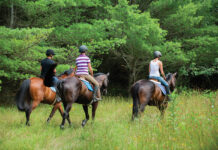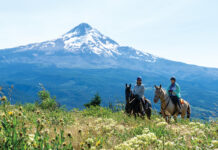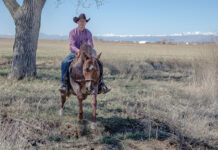If you wish you could just saddle up Old Paint and trot off into the wilderness for a few days, but come up short because you don’t have an extra horse to handle all your gear, you’ll love ultralight horse packing.
Ultralight combines the new generation of lightweight backpacking equipment with leave-no-trace camping and traditional horsekeeping. The result gets you into the backcountry and keeps you there, with only one saddle horse per person. No extra stock, pack frames, puzzling knots or awkward bags of feed. Just you, your friends and your horses.
For the past nine years, Karen Bragg and her family have ridden into Oregon’s Three Sisters Wilderness for days at a time with only the supplies and gear they can carry on their saddles. Karen, the president of Oregon Equestrian Trails, has trained as a Leave-No-Trace Master Educator specializing in pack stock at the National Outdoor Leadership School in Lander, Wyo.
The Braggs’ average trip is six days with three to six riders. Since their first ride they have fine-tuned their equipment list to come up with the ultimate essentials. Here’s what it takes to go ultralight.
Choosing Your Trail
The key to planning an ultralight trip is grass and water. When your horses can
| Leave No Trace Learn more about Leave-No-Trace Leave No Trace Center for Outdoor Ethics (800) 332-4100; www.lnt.org National Outdoor Leadership School (NOLS) (800) 710-6657; www.nols.edu You can pick up pamphlets on leave-no-trace |
graze, you won’t need bags of alfalfa pellets or other feed. You can find good grazing by asking people who’ve been to the area you intend to ride or by studying maps. Look for maps that show forested areas and topographic features. Grassy meadows usually appear as non-forested and relatively flat. Recreation staffs at nearby Forest Service or Bureau of Land Management offices can provide tips on horse camps, trails and camping spots with good grass. Grazing is restricted on some publicly owned land, so be sure to check with the agency in charge. Karen grazes her horses for two or three hours first thing in the morning and again in the evening while making camp.
Stop at stream crossings during the day to offer your horses a drink. Try to make camp within a half-mile of a good stream or lake and take your horses to water in the evening and morning. Leave-no-trace guidelines recommend keeping stock and gear at least 200 feet from lakes, streams, trails and other camps. Karen avoids turning her horses out in wet areas, which are easily damaged by animals that weigh over a half ton and can sink up to their fetlocks in mud.
“You’re trying to leave no trace,” she says, “and a horse on marshy ground is going to leave post holes. The whole idea [to this type of camping] is that no one will know you’ve been there.”
Equipment
You can pack everything you need into saddlebags, an oversized cantle bag and
| Ultralight Gear The gear you’ll need falls into two Any good outdoor store, and a number Campmor (800) 226-7667; www.campmor.com REI (Recreational Equipment Inc.) (800) 426-4840; www.rei.com Country Supply offers a Country Supply (800) 637-6721; www.countrysupply.com Outfitters Supply offers the Outfitters Supply (888) 467-2256; www.outfitterssupply.com |
One rider’s saddlebags carry the kitchen—pots and pans, utensils and the stove. The other riders fill their saddlebags with food. Horn bags are for personal gear like toothpaste, hairbrush, sunscreen and cameras. Each rider carries a bathroom kit—a reclosable plastic bag with toilet paper, a small folding shovel and other necessities—and follows leave-no-trace techniques to dispose of human waste. Karen packs a basic first-aid kit for people and horses, and makes her own fly wipes by putting a piece of terrycloth in a reclosable plastic bag and pouring fly spray over it.
How you attach the various bags depends on what type of saddle you use. Western saddles, which have more connection points, can be easier to load than English saddles, but Karen’s daughter rides English and carries her full share of gear.
Saddlebags and horn bags need to be balanced, both for the horse’s comfort and to keep them from slipping. Weigh each side at home to see how you’re doing.
Once you’ve settled on your gear and how to pack it, practice loading your horse at home. Take a short ride and check that your knots and buckles are holding, and that the gear is staying in place. You want everything snugged down tightly enough that you can trot for a short distance without too much flapping or banging around.
Karen expects her horses to tote one rider and a maximum load of about 45 pounds. The cantle bags weigh about 20 pounds and the saddlebags 15, for a total of 35 pounds behind the saddle. Horn bags carry up to 3 pounds.
Camp Cooking
A typical menu for the Braggs includes oatmeal or pancakes and ham for breakfast, tuna sandwiches for lunch on the trail, and packaged noodle or rice meals for dinner.
Karen’s secret for packing food is repackaging. She opens boxes, cuts out the preparation instructions, and repackages the contents and instructions into reclosable plastic bags. She buys tuna or preseasoned cooked hamburger in pouches, uses powdered milk and replaces butter, which could spoil on the trail, with salad oil.
“We eat pretty good,” Karen says. “It wouldn’t be something you’d do at home, but at 6,000 feet it’s kind of amazing to cook like that.”
You can freeze your first dinner the night before you set out. By the time you make camp the following day the meal will be thawed and ready to warm up over the stove.
You’ll need a water filtering or purifying system, available from most outdoor equipment stores or catalogs, to treat drinking water from streams or lakes.
Horse Management
The Braggs use highlines to secure their horses at night. They carry the highline equipment—50 feet of mountain-climbing rope, tree-saver straps and knot-eliminator hardware—in a cantle bag on a western saddle. Horses that tend to paw while tied are hobbled by both front feet to stop them from digging holes in the highline area.
For grazing hobbles, Karen uses a halter, a single neoprene cuff hobble, and a 12-
About the Author |
inch trailer tie with a quick-release or “panic” snap on one end and a bull snap on the other. The quick release is fastened to the hobble, the bull snap to the halter, below the chin. Once hobbled, the horse cannot lift his head or run, but can walk easily, even across rough ground.
“You’re talking about horses that have worked pretty much all day long, or stood on a highline all night,” Karen says. “You put them on grass with this hobble, and they don’t want to pick their heads up.”
Where there are horses, there is horse manure. The leave-no-trace guidelines specify dumping animal waste at least 200 feet from water, trails or campsites. Karen says that spreading it out is even better.
“One pile of manure will sit there for months,” she says. “If you kick it around, the little road apples will dry and dissolve and be gone in a week or two.”
For the same reason, don’t let your horse stop on the trail to make a deposit. Keep him moving, and the manure will naturally scatter behind him, speeding up decomposition and causing less bother for other trail users.
After they break camp, the Braggs scatter the manure in the grazing and highline areas and fill in any holes the horses may have left. They drag a dead branch over the area, followed by handfuls of pine needles, to erase the signs of their presence.
“We walk away and look back,” Karen says, “and you’d swear nobody had been there.”
Backcountry Horse Training
Your horse needs to be in good physical condition for this kind of trail riding. He should be able to walk cross-country, go up and down steep slopes, and cross logs and streams. He should be comfortable carrying saddlebags that may rattle or snag on trees. He should stand quietly while tied, and you should be able to pull a jacket on without dismounting.
Backcountry horses need to be well trained for rider safety but also, Karen emphasizes, in order to protect the environment. A horse that paws while tied to a tree compacts the soil, which not only leaves an unsightly ring but can damage or kill the tree. A horse that fights his rider at a stream crossing is not only dangerous but tramples the bank and pushes sediment into the water.
Practice with your horse at home. Teach him to tie and stand patiently. Rig your highline and tie him the way you will in camp. Longe him with saddlebags filled with rattling empty pop cans. Make a point of crossing water, logs and other obstacles during your regular rides.
Try to schedule a farrier visit a week or two before your trip. New shoes that are going to come off usually do so within a few days of shoeing. You don’t want to take your horse into the wilderness at the tail end of the shoeing cycle either, when clinches are working loose and hooves are growing long. Carry an Easy Boot or similar protective horse boot, so you’ll have a replacement if he does lose one.
“You are going beyond a day’s ride from the trail head,” Karen says. “That’s the point, after all. You do not want to get yourself or your horse hurt when you are so far away from help.”
To get the most out of ultralight horse packing, start with short trips, refine your gear and packing techniques, and then move on to some of the most beautiful places on earth.





